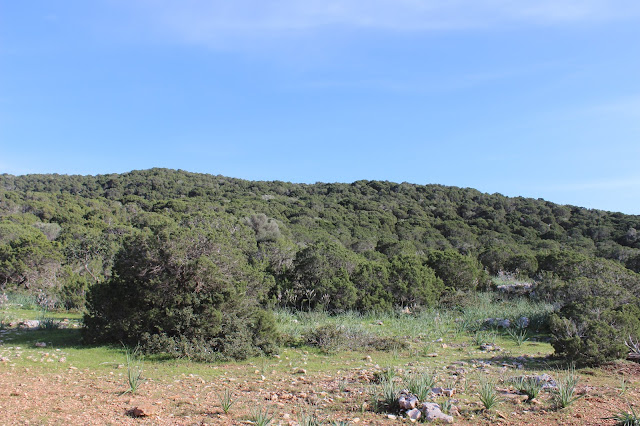
 Juniperus phoenicea, the Phoenicean juniper or Arâr, is a juniper found throughout the Mediterranean region, from Morocco and Portugal east to Italy, Turkey and Egypt, south on the mountains of Lebanon, Israel, Jordan, and in western Saudi Arabia near the Red Sea, and also on Madeira and the Canary Islands. It mostly grows at low altitudes close to the coast, but reaches 2,400 metres (7,900 ft) altitude in the south of its range in the Atlas Mountains.
Juniperus phoenicea, the Phoenicean juniper or Arâr, is a juniper found throughout the Mediterranean region, from Morocco and Portugal east to Italy, Turkey and Egypt, south on the mountains of Lebanon, Israel, Jordan, and in western Saudi Arabia near the Red Sea, and also on Madeira and the Canary Islands. It mostly grows at low altitudes close to the coast, but reaches 2,400 metres (7,900 ft) altitude in the south of its range in the Atlas Mountains.
Juniperus phoenicea is a large shrub or small tree reaching 2–12 metres (6.6–39.4 ft) tall, with a trunk up to 1 metre (3.3 ft) diameter and a rounded or irregular crown. The leaves are of two forms, juvenile needle-like leaves 8–10 mm long on seedlings, and adult scale-leaves 0.5–2 mm long on older plants; they are arranged in opposite decussate pairs or whorls of three. It is largely monoecious, but some individual plants are dioecious. The cones are berry-like, 6–14 mm in diameter, orange-brown, occasionally with a pinkish waxy bloom, and contain 3-8 seeds; they are mature in about 18 months. The male cones are 2–4 mm long, and shed their pollen in early spring.
The tree's essential oil is especially rich in the tricyclic sesquiterpene thujopsene; the heartwood contains an estimated 2.2% of this hydrocarbon. The biochemist Jarl Runeburg noted in 1960 that "Juniperus phoenicea appears to be the most convenient source of thujopsene so far encountered.
From Wikipedia, the free encyclopedia
Photos Rizokarpaso 17/11/2014 by George Konstantinou
 ο Αόρατος ή Άρκευθος η Φοινικική ( Juniperus Phoenicea) και ανήκει στην οικογένεια των Κυπαρισσιδών. Ο Αόρατος φυτρώνει στα ημιορεινά μέρη. Υπάρχει στην οροσειρά του Πενταδακτύλου και του Τροόδους. Επιβιώνει κάτω από αντίξοες συνθήκες. Το ύψος του φθάνει ως τα 15 μ. Παλαιότερα στην Κύπρο, οι κάτοικοι της υπαίθρου και ιδιαίτερα όσοι κατοικούσαν σε περιοχές που φυτρώνει ο Αόρατος, έδειχναν μια ιδιαίτερη προτίμηση και εκτίμηση για το δέντρο αυτό. Διότι το ξύλο του είναι σκληρό και εμποτισμένο μ’ ένα είδος ρητίνης που του δίνει μια ευχάριστη μυρωδιά και το κάνει σκληρό, ανθεκτικό , δεν σαπίζει εύκολα και δεν προσβάλλεται από έντομα.
ο Αόρατος ή Άρκευθος η Φοινικική ( Juniperus Phoenicea) και ανήκει στην οικογένεια των Κυπαρισσιδών. Ο Αόρατος φυτρώνει στα ημιορεινά μέρη. Υπάρχει στην οροσειρά του Πενταδακτύλου και του Τροόδους. Επιβιώνει κάτω από αντίξοες συνθήκες. Το ύψος του φθάνει ως τα 15 μ. Παλαιότερα στην Κύπρο, οι κάτοικοι της υπαίθρου και ιδιαίτερα όσοι κατοικούσαν σε περιοχές που φυτρώνει ο Αόρατος, έδειχναν μια ιδιαίτερη προτίμηση και εκτίμηση για το δέντρο αυτό. Διότι το ξύλο του είναι σκληρό και εμποτισμένο μ’ ένα είδος ρητίνης που του δίνει μια ευχάριστη μυρωδιά και το κάνει σκληρό, ανθεκτικό , δεν σαπίζει εύκολα και δεν προσβάλλεται από έντομα. Από ξύλο αοράτου έκαναν τα δοκάρια ( βολίτσια) της στέγης των σπιτιών, καθώς και τα « σσιάτζια » σχίδακες που έβαζαν πάνω από τα « βολίτσια » . Επίσης οι κοπέλες έκαναν τα ερμάρια τους και τα σεντούκια τους με ξύλο αοράτου. Γιατί από τη μια τα ρούχα δεν τα πείραζαν τα έντομα ( σκώρος κλπ) και από την άλλη ανοίγοντας το ερμάρι ξεχυνόταν μια ευχάριστη μυρωδιά στο σπίτι, την οποία είχαν και τα φορέματα που φυλάγονταν μέσα.
Από ξύλο αοράτου έκαναν τα δοκάρια ( βολίτσια) της στέγης των σπιτιών, καθώς και τα « σσιάτζια » σχίδακες που έβαζαν πάνω από τα « βολίτσια » . Επίσης οι κοπέλες έκαναν τα ερμάρια τους και τα σεντούκια τους με ξύλο αοράτου. Γιατί από τη μια τα ρούχα δεν τα πείραζαν τα έντομα ( σκώρος κλπ) και από την άλλη ανοίγοντας το ερμάρι ξεχυνόταν μια ευχάριστη μυρωδιά στο σπίτι, την οποία είχαν και τα φορέματα που φυλάγονταν μέσα.Ένας γίγαντας Αόρατος υπάρχει στο χωριό Ακανθού, στη βόρεια πλευρά του Πενταδάκτυλου , της επ. Αμμοχώστου. Σήμερα δεν ξέρουμε τι γίνεται. Ευρίσκεται 6 μίλια περίπου μακριά από το χωριό, κοντά στον δρόμο Ακανθούς –Φλαμουδιού , στο δυτικό μέρος του εξωκκλησιού του Αγίου Χαραλάμπους. Η περιφέρεια του κορμού είναι 2 μ.περίπου και το ύψος του 8 μ.
Άλλος αιωνόβιος Αόρατος υπάρχει στο Ακρωτήριο Κάβο Γκρέκο στην ελεύθερη περιοχή της επ. Αμμοχώστου και ένας άλλος στην περιοχή « Λούματα τους Ατούς » στο δάσος του Τροόδους.
Πηγή http://www.diakonima.gr
 |
| Δάση Juniperus phoenicea στην Καρπασία |






No comments:
Post a Comment